This article was published in Scientific American’s former blog network and reflects the views of the author, not necessarily those of Scientific American
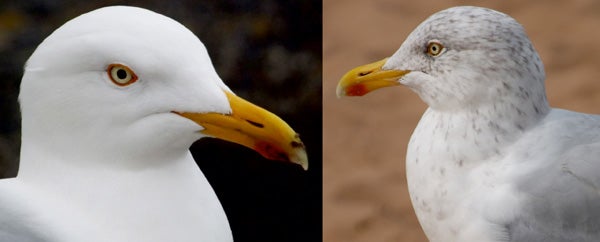
Portraits of British Herring gulls. The bird on the right is in winter plumage.
I think gulls are great, and I’m especially fond of the so-called white-headed gulls: the group of species that includes the familiar Herring gull Larus argentatus, the black-backed gulls, and a list of similar species that occur worldwide. These are the only gull species unambiguously associated with the name Larus. Taxonomic revisions, based on new models of gull phylogeny, have meant that many of the other gull lineages are no longer associated with this name (Pons et al. 2005).
White-headed gulls are frequently encountered and easy to get close to and photograph, especially here on the maritime fringes of the European continent. I, personally, regard them as among the best-looking and most awesome of all birds. And I don’t mean ‘awesome’ in the vacuous, generic sense, but in the real sense: these birds are gargantuan, hook-billed, brilliantly white beasts way bigger than most of the other birds we regularly encounter. Their wingspans typically exceed 1.3 m and they’re quite capable of killing and eating birds of more ‘average’ size, including passerines of many sorts as well as feral pigeons.
On supporting science journalism
If you're enjoying this article, consider supporting our award-winning journalism by subscribing. By purchasing a subscription you are helping to ensure the future of impactful stories about the discoveries and ideas shaping our world today.
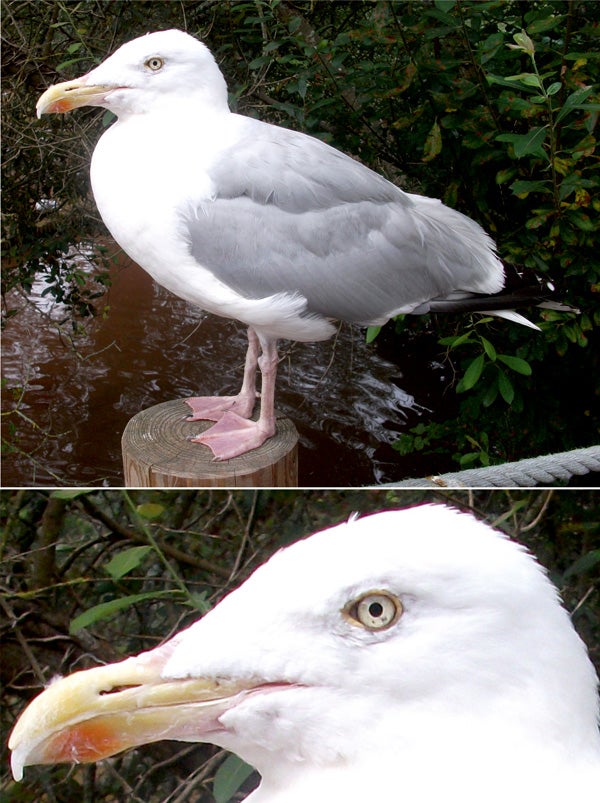
Especially big Herring gull encountered at Paignton Zoo. This bird has a strongly hooked, gnarly bill. I wonder if it was an old individual.
Over the years I’ve had substantial opportunity to photograph white-headed gulls at many places, and I’ve long been looking for an excuse to use these photos on Tet Zoo. Today, that excuse has arrived. Below, find a (hopefully) interesting list of ‘facts’ about white-headed gulls, accompanied by many of my photos. Given the harsh time gulls have been getting in the UK press of late, it’s also a good time to redress the balance.
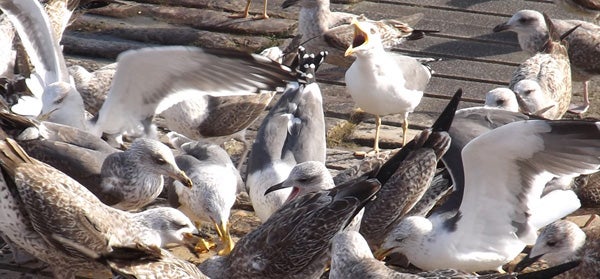
Feeding and squabbling gulls photographed at Lisbon, Portugal. It's typical for gull groups like this to consist of fully adult birds as well as juveniles and subadults that are in various plumage stages.
White-headed gulls are long-lived and slow to mature. Thanks to ringing data, we know that white-headed gulls of several species are really long-lived, certainly living into their fourth decades. A Herring gull ringed in 1965 was seen alive in 1997 (making it 32 years old at the time), and a British Lesser black-backed gull L. fuscus was 34 years old when shot in 2009. This sort of longevity isn’t unique to white-headed gulls though: Black-headed gulls Chroicocephaus ridibundus also have a confirmed lifespan of 32 years (van Dijk et al. 2012). An individual that lived for over 33 years has since been reported.
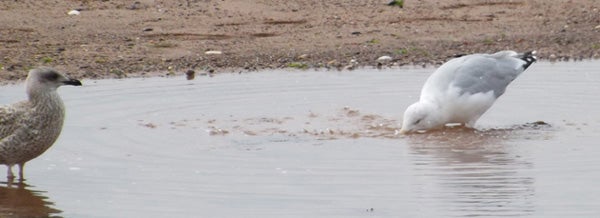
Another typical scene (this time showing Herring gulls at Orton, Devon): post-fledging juvenile and adult in close proximity. The adult was trying to remove unwanted material sticking to the sides of its bill.
White-headed gulls mature slowly compared to the majority of other birds, most of which complete growth in less than a year. But white-headed gulls take four years to take on their full adult appearance, the result being that individuals can be sorted into distinct ‘year classes’ on the basis of plumage. The resulting situation is unusual compared to what’s typical in birds: living alongside and foraging alongside individuals in fully adult plumage are independent-living juveniles representing several different ontogenetic stages. The process at play here is called deferred maturity. It leads us to the next issue...
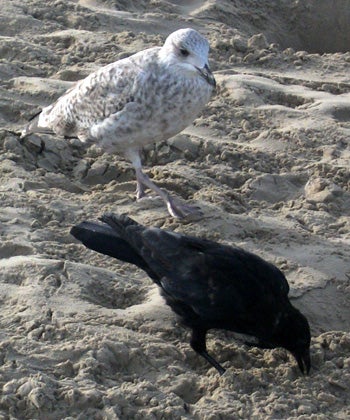
Juvenile Herring gull (in second year plumage) hoping to rob food from a beach-foraging Carrion crow Corvus corone at Weymouth.
Some white-headed gulls practise surprisingly long periods of parental care. Parental care in gulls generally ceases as the fully fledged young disperse from their nests. In white-headed gulls this typically happens at about 10 weeks (70 days, or 2.3 months) (Spear et al. 1986). However, far more extended cases of parental care are on record. Burger (1980) described cases in the Western gull L. occidentalis where post-fledging juveniles were still receiving parental care despite being 17-25 weeks old (120-180 days, or 4-6 months). A juvenile Southern black-backed gull L. dominicanus fed by an adult at Wellington, New Zealand, was most likely 28 or 29 weeks old (196-203 days, or about 6.5 months), and at minimum 17 or 18 weeks old (119-126 days, or about 4 months) (Powlesland 1996). Such extended parental care has also been reported in the Glaucous-winged gull L. glaucescens, Herring gull and other species. Post-fledging parental care is also common in terns, skimmers and some other seabirds. An extreme version is seen in frigatebirds where juveniles are sometimes receiving parental care an absurd 57 weeks (400 days, or over 13 months) after fledging. But, then, most things about the biology of those birds are extreme.
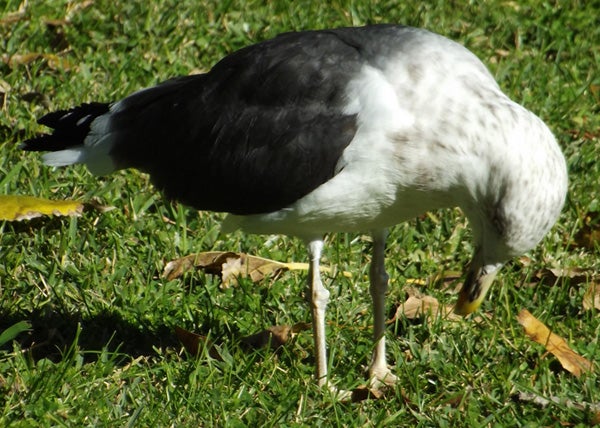
White-headed gull in a Lisbon park staring at its feet. I'm not sure what sort of gull this is. It had pinkish legs and white primary spots, so isn't a Lesser black-backed gull, isn't not dark enough or heavy-billed enough to be a Great black-backed gull, and it's too dark-mantled to be a Herring or Yellow-legged gull. Thoughts?
Gulls are animals of leisure. There might be an idea among people that gulls spend their entire lives questing for food, or squabbling with neighbours. In fact, they spend an inordinate amount of time ‘loafing’: standing around, doing nothing except watching the world around them. They might actually only spend a mere 2 or 3 hours per day foraging (Pierotti & Good 1994). For long-lived animals that are adaptable opportunists with access to numerous resources, it makes sense that they have ‘free time’. White-headed gulls have storms, cold weather, skuas, falcons, domestic dogs and hateful humans to worry about. But, otherwise, they actually have comparatively easy, leisurely lives.
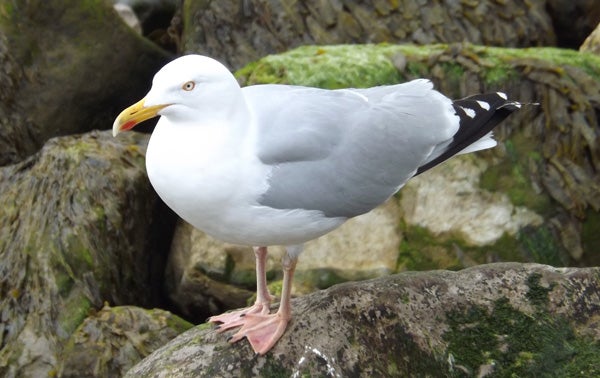
A Herring gull on the shore at Lyme Regis, Dorset, doing what white-headed gulls do best: standing there, wasting time. It's called 'loafing'.
Gulls are (reasonably) smart, complex animals. Gulls are not the dumb brutes many people assume they are. They’re documented tool-users, the Herring gull sometimes using bread as bait when catching fish (Henry & Aznar 2006). They repeatedly ‘paddle’ the ground to bring worms to the surface (a behaviour sometimes called worm-baiting). Their well-studied technique of dropping bivalve shells on hard surfaces to break them open is often equated with a sort of intelligence (though feel free to debate that), and they definitely display a marked amount of innovation as goes what they will eat and how they’ll deal with it. Herring gulls have been seen drowning baby rabbits and also dropping them from height onto rocks (Young 1987) and a number of anecdotes indicate an ability to outwit other animals and associate given events and objects with food. You may have seen the bit of footage where a Herring gull walks into a shop and leaves with a stolen packet of crisps. Gull body language is complex – they have a repertoire of vocal and visual signals that involve different calls, wing and body postures, and they also pull at nearby plants when displaying anger or frustration (Nelson 1980).

Herring gull (in Southampton) engaging in worm-baiting.
But... are gulls really “smart”? This issue is surprisingly little-studied. Despite a relatively small forebrain/brainstem size difference (Zorina & Obozova 2012), white-headed gulls certainly score well in terms of their ability to innovate and apply new solutions to problems (an ability that is not, incidentally, as tightly linked with a generalist lifestyle as used to be thought: see Overington et al. 2011). There’s some indication that innovation is related to ‘greater cognitive capacity’, or smartness (Overington et al. 2009). However, white-headed gulls seem unable to perceive or visualise hidden objects, or extrapolate the position of a partially concealed object (Zorina & Obozova 2012). If we combine our data on relative brain size, adaptability and innovation, and the overall problem-solving abilities of gulls, it seems that they’re in the ‘lower’ realms of avian intelligence: not that different from pigeons and doves, somewhat smarter than chickens and other gallinaceous birds, substantially less smart than crows and parrots, but also less smart than familiar passerines like finches and thrushes. Of course, all of this is subject to debate and further investigation.
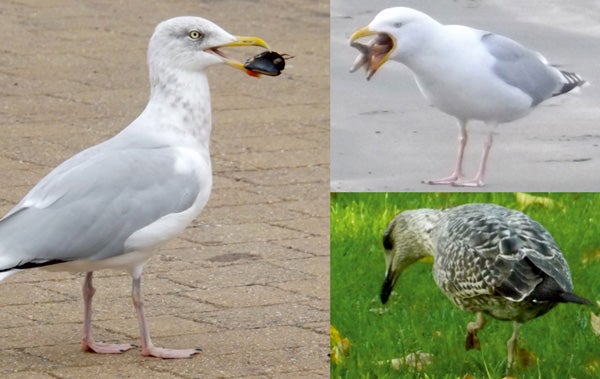
White-headed gulls engaging in various foraging and feeding activities: breaking open bivalves, swallowing sea stars, foraging in grassland for terrestrial invertebrates. The adults shown here are Herring gulls; the juvenile is a Lesser black-backed gull in its first year.
Gulls are (probably) important ecosystem service providers. Popular mythology and media-driven lore has it that Herring gulls and other white-headed gulls are vile feathered sky-rats, good-for-nothing harbingers of doom, vectors of filth and disease, and worthless thieves. While there’s no arguing that large gulls may well ruin the occasional outdoor event, strike people about the head now and again, and make certain places messy through their scavenging and lavatorial habits, this view of gulls as all negative all the time is naive and ignores the tremendous amount of good they do. You see, white-headed gulls don’t just eat picnic food and things stolen from the hands of children. They also remove and ingest a huge amount of crap that we don’t want, need, or like hanging around, including organic refuse of many kinds, dropped food, the remains of fish and other animals washed up on coasts, and (most appetisingly of all) dog scat. It also turns out that they’re important seed dispersers, being responsible for ecological regeneration in areas where other birds have little such role (Iason et al. 1986, Magnusson & Magnusson 2000, Sekercioglu 2006). In other words, white-headed gulls may well be what we call ecosystem service providers.
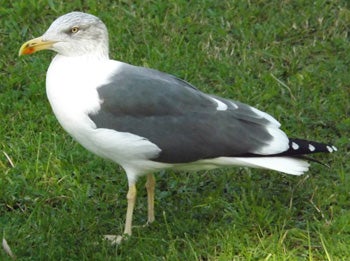
Winter plumage Yellow-legged gull L. michahellis photographed at Lisbon. Distinguishing features include yellowish legs, darkish mantle and obvious white spots on the primaries.
But gulls are also (probably) important vectors of disease, sometimes. I can’t pretend that white-headed gulls are all good. It’s widely thought that gulls spread the harmful bacteria Escherichia coli and Enterococcus, contaminating beaches to the extent that they’re considered unsafe for people (Fogarty et al. 2003). Outbreaks have been linked to major outbreaks of illness and even death among people; consequently, some considerable effort has been put into reducing gull populations and removing gull droppings in the areas concerned. Wires erected at beaches in Ottawa have been installed to deter gulls from visiting and Chicago has used trained dogs to chase gulls away and hence keep the beaches clean. It certainly seems like the gulls are the bad guys in this story. However, it should be noted that the evidence linking them to the bacterial contaminations concerned is doubted by some.
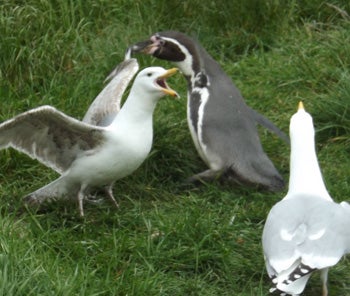
Who would win in a fight between a white-headed gull and a penguin? A scene photographed at the Welsh Mountain Zoo in May 2015.
Gulls of many (perhaps most) populations are in decline. While white-headed gulls of several species (Herring gulls in particular) are frequently said to be increasing exponentially in population size, this in fact only applies to urban populations: the overall populations of these birds are plummeting. The UK population of the Herring gull is currently at its lowest level since recording began in 1969/70 (Joint Nature Conservation Committee 2014). Believe it or don’t, it’s now a Red List species. Another familiar species in Europe – the Lesser black-backed gull – was increasing in census after census between the mid-1980s and late 1990s, but then crashed during the 21st century, its 2013 total population being lower than that of 1986 (Joint Nature Conservation Committee 2014). In North America, the Herring gull/Smithsonian gull population has declined by about 78% since the 1960s, meaning that it’s in steep decline overall (Pierotti & Good 1994).
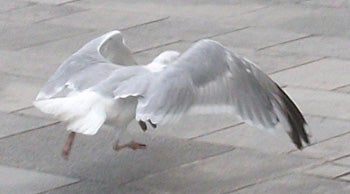
A Herring gull in Southampton takes flight.
It’s often been argued that gulls (and other seabirds) are ‘boom and bust’ species whose populations fluctuate widely, and some historical data supports that. But prolonged, consistent declines occurring across large parts of the ranges of certain of these species are cause for concern, especially because they seem linked to things which we know are a problem, like declining marine resources. This is what makes efforts to eradicate or eliminate urban gull populations such a farce – people are, apparently without concern, aiming to reduce species that seems to be in chronic decline and which need help, not persecution.
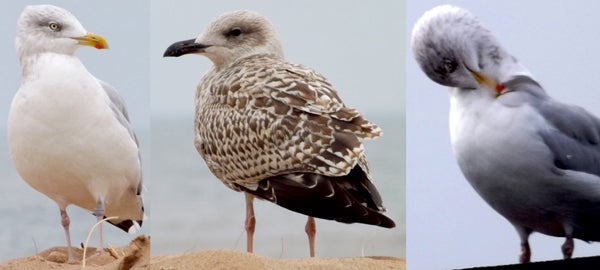
Selection of Herring gulls photographed at Orton, Devon.
No, the Herring gull is not a ring species. For years, textbooks and articles about evolution paraphrased Ernst Mayr’s hypothesis that the white-headed gull populations of northern Eurasia and North America formed a reproductively continuous ‘ring species’. While adjacent populations could interbreed, the populations at the extreme ends of the ring could not. Ergo, the ‘end’ points had reached reproductive isolation: speciation had occurred (Mayr 1942).
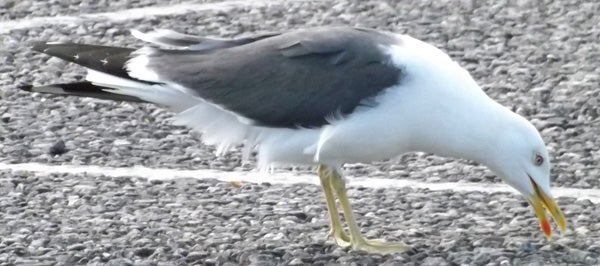
Lesser black-backed gull L. fuscus at Highcliff, Hampshire. Note yellow legs, dark mantle and only tiny white spots on its primaries.
This model began to fall apart in the 1990s when it was shown that various of the populations thought to belong to the ring were actually distinct phylogenetic entities with their own histories. Evolution hadn’t occurred in the stepping-stone-like fashion integral to the ring model: instead, the populations had moved in diverse different ways and were not necessarily living in close proximity to their evolutionary neighbours. In short, the evolutionary history of these gulls is substantially more complex than posited by Mayr, and the ring model is not valid (Liebers et al. 2004). In case this seems disrespectful to Mayr – one of the greatest and most influential of evolutionary thinkers – we should always be fair and explain that his model for white-headed gull evolution fell apart within the theatre of molecular phylogenetics, the tests and techniques concerned being unavailable to him during the 1940s.
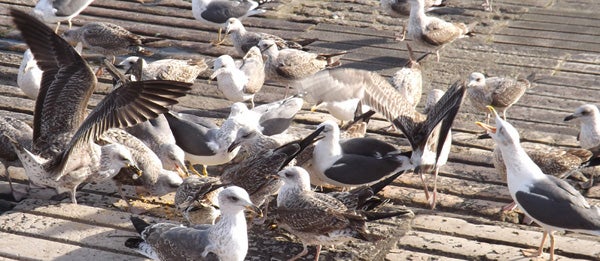
White-headed gulls of several plumage stages pick up food in Lisbon, or complain about the fact that they're not getting any.
There is lots more to say about white-headed gulls, some of which I planned to cover in this article. But I think that’s enough for now. If you didn’t already share my appreciation of gulls, I hope you were intrigued or enthralled by various of the things discussed here. These really are very special birds, and I’ve no doubt that they’ll be covered here again at other points in the future.
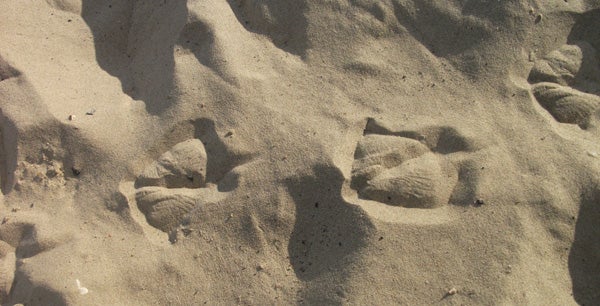
Herring gull tracks on the beach at Weymouth...
For previous Tet Zoo articles on gulls and other seabirds, see...
Why the Lion Grew Its Mane, a book review (covers gulls)
Mobile phones, medals, a doll's legs, an entire army... is there anything a gull won't swallow?
A symbiotic relationship between sunfish and albatrosses? Say what?
Living the pelagic life: of oil, enemies, giant eggs and telomeres (petrels part II)
Petrels: some form-function ‘rules’, and pattern and pigmentation (petrels part III)
Putting petrels in their place and the possibly weird evolution of albatrosses (petrels part IV)
Refs - -
Burger, J. 1980. The transition to independence and postfledging parental care in seabirds. In Burger, J., Olla, B. L. & Winn, H. E. (eds) Behavior of Marine Animals, Vol. 4: Marine Birds. Plenum, New York, pp. 367-447.
Fogarty, L. R., Haack, S. K., Wolcott, M. J. & Whitman, R. L. 2003. Abundance and characteristics of the recreational water quality indicator bacteria Escherichia coli and enterococci in gull faeces. Journal of Applied Microbiology 94, 865-878.
Henry, P.-Y. & Aznar, J.-C. 2006. Tool-use in Charadrii: active bait-fishing by a Herring Gull. Waterbirds 29, 233-234.
Iason, G.R., Duck, C. D. & Clutton-Brock, T. H. 1986. Grazing and reproductive success of red deer – the effect of local enrichment by gull colonies. Journal of Animal Ecology 55, 507-515.
Liebers, D., de Knijff, P. & Helbig, A. J. 2004. The herring gull complex is not a ring species. Proceedings of the Royal Society of London B 271, 893-901.
Magnusson, B. & Magnusson, S. H. 2000. Vegetation on Surtsey, Iceland, during 1990–1998 under the influence of breeding gulls. Surtsey Research 11, 9-20.
Mayr, E. 1942. Systematics and the Origin of Species. Columbia University Press, New York.
Nelson, B. 1980. Seabirds: Their Biology and Ecology. Hamlyn, London.
Overington, S. E., Morand-Ferron, J., Boogert, N. J. & Lefebvre, L. 2009. Technical innovations drive the relationship between innovativeness and residual brain size in birds. Animal Behaviour 78 1001-1010.
- ., Griffin, A. S., Sol, D. & Lefebvre, L. 2011. Are innovative species ecological generalists? A test in North American birds. Behavioral Ecology 22, 1286-1293.
Pierotti, R. J. & Good, T. P. 1994. Herring gull. In Poole, A. & Gill, F. (eds) The Birds of North America, No. 124. The Academy of Natural Sciences, Philadelphia; The American Ornithologists’ Union, Washington, D.C.
Powlesland, R. G. 1996. Extended parental care of the Southern black-backed gull (Larus dominicanus). Notornis 43, 196.
Sekercioglu, C. H. 2006. Increasing awareness of avian ecological function. Trends in Ecology and Evolution 21, 464-471.
Spear, L. B., Ainley, D. G. & Henderson, R. P. 1986. Post-fledging parental care in the Western gull. The Condor 88, 194-199.
van Dijk, K., Oosterhuis, R., Middendorp, B. & Majoor, F. 2012. New longevity records of Black-headed Gull, with comments on wear and loss of aluminium rings. Dutch Birding 34, 20-31.
Young, H. G. 1987. Herring gull preying on rabbits. British Birds 80, 630.
Zorina, Z. A. & Obozova, T. A. 2012. New data on the brain and cognitive abilities of birds. Biology Bulletin 39, 1-17.